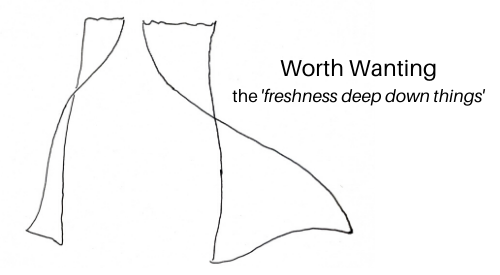
We need stories about encounters and encountering to contemplate and tell each other for information and inspiration. Of course, we can go to history, news reports and literature for stories about encounters, actual and fictional, but what exactly are we looking for in accounts of encounters?
I think what we’re really after in any account of an encounter is the drama of livingnesses. New facts may turn up, corrections be make, general opinions changed, but the drama itself has perennial power in our imaginations.
Livingness. It’s an essential word but what exactly do I mean by it? It’s a measure of change in our readiness to recognize others as others (vs objects), our readiness to risk exposure to others (by making common cause), and our readiness to respond with changes to the contours, contents and internal configurations of our alteria, our personal context of others. The word livingness applies to the transcendent realm, though it applies to encounters which occur in the context of the mundane.
Livingness is observable: a. readiness for recognition of others in the frequency of ‘you’ addressings; b. readiness for risk in the occasions of hospitality, friendship and exploration; c. readiness for meaningful response with change in the ways our pep clues evolve. It’s changes in these that we’re looking for in our examination of encounter accounts. Of course, we have to query these stories closely: how sincerely were others addressed as ‘you’, how genuine were the risks in the exposure, how authentic (vs cosmetic) were the responses of change, but these are considerations in the evaluation of all stories.
We can put livingness on a scale from high to low, positive to negative. High livingness is a tendency to regularly expand and adapt the scope and scale of one’s recognitions, risks and responses. Low livingness is a tendency to have few or no new recognitions, risks, or responses. The result of this restriction is experiential familiarity and behavioral habit. (Think of velocity and acceleration, speed and the rate of change of speed.)
Positive livingness is the policy of seeking ever more encounters in more ways with more types of others with more profound responses. By contrast, negative livingness is a policy of rejection of others and othernesses, risks and significant responses.
A person of positive livingness has a supple and dynamic perimeter between self and the realm of others, and an expanding alterium; a person of negative livingness, a stiff and defensive one and a shrinking alterium; a person of zero livingness has a largely static perimeter and alterium. Positive livingness, through its focus on hospitality, friendship and exploration, encourages generosity, steadfastness and courage and so counters the ever present risks of selfishness, unfaithfulness and faint-heartedness.
The drama of encounters is in the changes in the openness of the participants, low to high, negative to positive.
At any moment in an encounter account, we can ask about the participants: are they ready to entertain the prospect of an encounter and also willing (ready to say yes) as opportunity presents itself? Or ready to consider encountering, but not really ready to enter? Or not ready to consider encountering but actually ready to plunge in? Or not ready to entertain encountering at all, and committed to rejecting opportunities to encounter.
It’s following the livingness of each participant in an encounter taking place in the context of mundane urgencies that makes accounts of encounters so interesting, that is, so impressive, intriguing, intimate.
So in history, we can explore the long enounter of indigenous people and English colonists on the island of Nantucket off Massachusetts, with an eye out for dramas of livingness within the often dispiriting tale.
So in current events, we can explore our ongoing encounter with the coronavirus, celebrating the learning and the loving going in our beleaguered hospitals.
So in literature we can explore fictions such as that in Puccini’s opera Turandot, which is what I’ll do at greater length in my next post.
